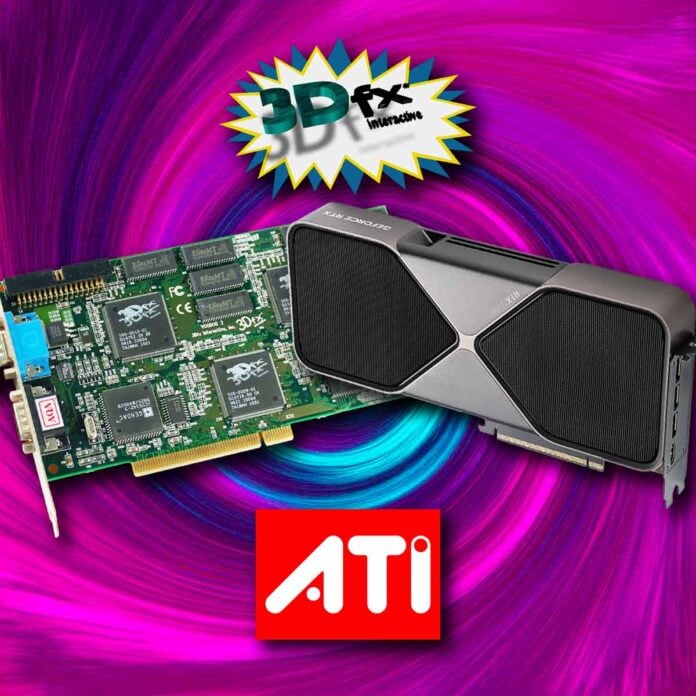Graphics cards have had a rollercoaster of a journey when it comes to PC gaming. Starting off with simple 2D cards, we went through the 3D accelerator boom in the 90s, and then hurtled toward today’s top GPU silicon, where ray tracing and AI are all part of the mix. Nvidia is now a household name, and PC GPU tech powers all the latest consoles, but which graphics cards have really had the biggest impact over the last few decades?
Most of us on Club386 have been PC gamers for a long, long time. We’ve seen (and benchmarked) it all, from 3dfx Voodoo cards to Nvidia Blackwell GPUs today. As such, we thought it would be fun to chart the ten GPUs that still really stand out to us. They’re not necessarily the fastest GPUs from each generation, but the ones that changed the game, had huge staying power, or simply offered incredible value for money. Some of these are technically graphics chipsets, rather than GPUs (we see you, pedants), and you may well have other ideas, but this is all the graphics tech that really awed us when it came out.
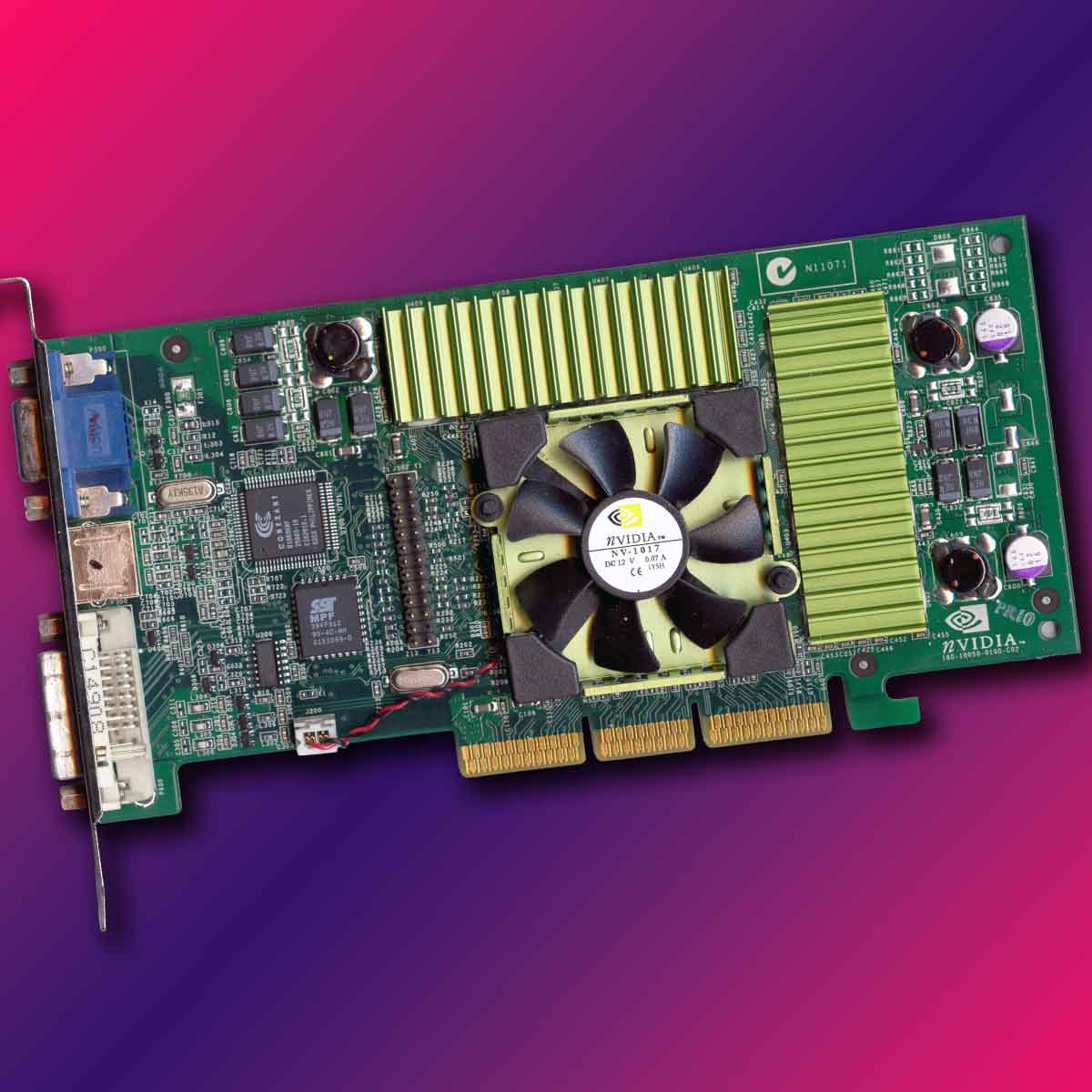
10. Nvidia GeForce 3
We thought the flat textures of PC games looked pretty good back in 2001, but then Nvidia introduced us to the wonderful world of shaders and everything changed. Tying in with the launch of DirectX 8, GeForce 3 gave game developers two new tools in the graphics pipeline – programmable pixel and vertex shaders.
That meant you no longer had to chase super-high polygon counts and high-res textures to create realistic effects in games. You could now also lean on the power of programmable shader cores that could busy themselves working on a range of algorithms to generate graphics instead. The impact on water effects and foliage was profound, creating a whole new level of realism – even a brick wall could now be rendered much more realistically, not to mention quickly.
The impact on water effects and foliage was profound, creating a whole new level of realism
Sadly for GeForce 3, the game industry took a while to catch up with its capabilities. Nvidia proudly showed off Doom 3 and a Pixar lamp demo at the launch, and they looked absolutely incredible, but Doom 3 then ended up being delayed by another three years.
Beyond a DirectX 8 patch for Giants: Citizen Kabuto, and the very fancy-looking Nature test in 3DMark2001, there wasn’t much else that took full advantage of GeForce 3’s shaders. But it did set the ball rolling for what was to come, and we now all know that shaders really did indeed change everything.

9. Nvidia GeForce RTX 5090
Proving there really is no upper limit to what cash-loaded PC gamers will pay to have the best of the best, RTX 5090 is a grand showcase of Nvidia’s might. It’s outlandishly powerful, extremely expensive, and its MSRP is practically fictional in the US, but there’s no doubt RTX 5090 is the pinnacle of gaming GPU performance right now.
Nvidia pulled out every single stop to make its flagship Blackwell gaming chip as powerful as possible. With no die shrink between Blackwell and Ada, Nvidia simply made its GPU bigger, while also refining the architecture, and packed a frankly ridiculous 21,760 CUDA cores into the chip.
It’s an incredible feat of engineering
It’s not all about the GPU here, though. Unlike most Blackwell gaming GPUs, RTX 5090 also significantly upgrades its VRAM system on every level. It has 32GB of GDDR7 memory, compared to RTX 4090‘s 24GB of GDDR6X, and its 512-bit memory interface is incredibly wide. The resulting total memory bandwidth of 1.79TB/s is simply mind boggling.
To top it all off, Nvidia managed to squeeze all this tech into a neat, dual-slot card for its Founders Edition models. It all adds up to an incredible feat of engineering that puts everything else to shame right now. It’s just a shame the price is so high, even at MSRP, and that Nvidia didn’t give the rest of its Blackwell lineup the same level of attention.

8. Nvidia GeForce RTX 2080
When it first came out, Nvidia’s Turing architecture was met with a degree of bafflement from PC gamers, including me. It wasn’t much quicker than Nvidia’s previous Pascal chips in most games, and its new ray tracing and AI features were supported in only a tiny handful of titles. I benched the RTX 2080 with Battlefield V when it came out, and you could only really enable ray tracing at the low setting without performance falling off a cliff. Once we’d moved past the messy launch, though, it soon became apparent that Nvidia was changing the PC gaming graphics landscape forever.
We take ray tracing options in games for granted now, but this was an enormous technical hurdle to overcome. Previously the domain of CPU-based farms that took hours to render a single frame, the idea you could do any sort of ray tracing in real time seemed preposterous. But over the years, various companies showed the potential for actually doing it with both CPUs and GPUs, and then in 2018, Nvidia made actual, interactive ray-traced gaming a reality. Reflections, lighting and shadows gained a whole new level of realism, and we entered the next generation of PC gaming graphics.
The idea you could do ray tracing in real time seemed preposterous
Being extremely computationally expensive, RTX 2080 also gave us our first taste of how AI could improve performance, with the initial version of DLSS using machine learning to upscale from lower resolutions. It looked horrible and blurry at first, but Nvidia kept refining it, and the latest transformer model is now basically witchcraft. Meanwhile, AMD was caught napping, and didn’t introduce its first GPUs with ray tracing until two years later, and even they were underpowered and had no specific AI hardware.
Fast forward to 2025, and games like Indiana Jones and the Great Circle require ray tracing hardware at the base level, while AI features such as DLSS upscaling and frame gen are supported in hundreds of games. It might not have set the world alight when it came out, but the RTX 2080 set the stage for the amazing ray-traced games we enjoy today.
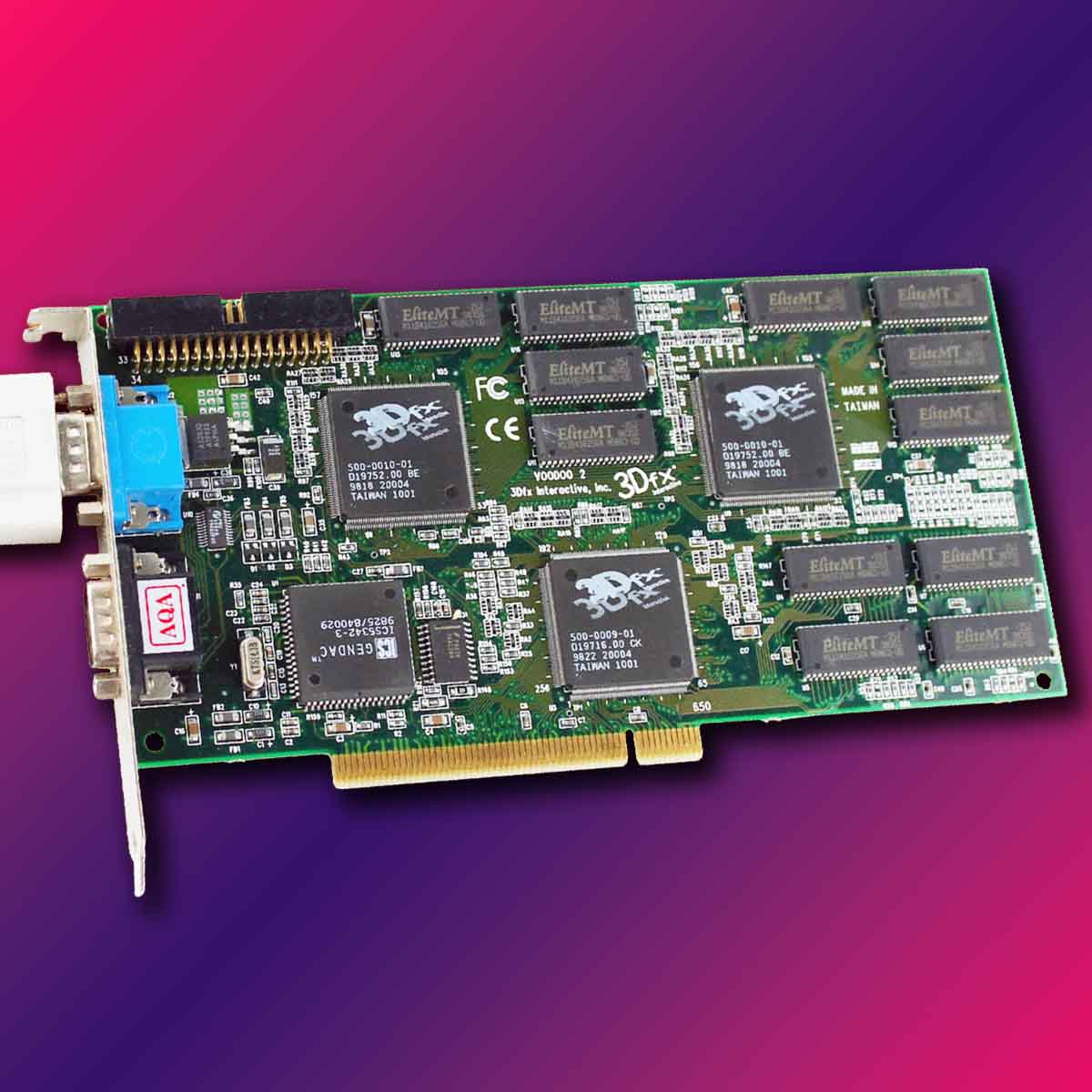
7. 3dfx Voodoo 2
After wowing PC gamers with its excellent Voodoo 3D accelerator cards, 3dfx quickly set to work on its successor, and the Voodoo 2 didn’t disappoint when it came out in 1998. Based on the same core principles as the first Voodoo card, with a loopback cable connecting it your 2D card’s VGA output, it seriously beefed up the specs.
There were some changes to the pipeline here, including processing triangle setup, which was previously handled by your CPU. Unlike the original Voodoo cards, it also added a third 3dfx-branded chip to the PCB, giving you two texture mappers working in parallel, rather than just one.
The ability to chain two of them together gave you the ultimate bragging rights
Meanwhile, a huge (at the time) frame buffer of either 8MB or 12MB of EDO memory enabled you to run your games at 800 x 600, rather than just 640 x 480 on the first Voodoo cards. Not only that, but you could also install a matching pair of Voodoo 2 cards, and connect them with a ribbon cable, thanks to a new feature called Scan Line Interleave (SLI).
Working in parallel on alternate scan lines – the horizontal lines making up a frame on your monitor – these two cards could then give you enough memory and horsepower to let you play games at, wait for it, 1,024 x 768. Voodoo 2 was still limited to 16-bit rendering, unlike some rival cards at the time, but 3dfx’s GLide support gave it an advantage, and the ability to chain two of them together offered ultimate bragging rights.

6. ATi Radeon HD 5870
ATi had been in the doldrums for a few years before it unleashed the excellent Radeon HD 5870 into the world. After being bought up by AMD in 2006, its Radeon HD 3000-series GPUs were only available as mid-range options, a bit like RDNA 4 today, and the Radeon HD 4000-series struggled to compete with Nvidia’s Tesla GPUs, such as the GeForce GTX 280.
But the ATi Radeon HD 5870 turned that situation on its head. Based on ATi’s Cypress core, the GPU die itself was comparatively small, measuring 334mm² and built on TSMC’s 40nm process. It made the GTX 280’s 576mm² Tesla die look massive. The pricing was perfect too, with its $399 MSRP significantly undercutting the GTX 280’s $649 launch price, forcing Nvidia to launch the GTX 285 at $359.
But the Radeon HD 5870 still had enough power to beat the higher-clocked GTX 285, and what’s more, it could even beat Nvidia’s next GPU. Based on the infamous Fermi architecture, Nvidia’s follow-up, the GTX 480, was expensive, hot-running, power-hungry, and worst of all, in several games it was slower than the Radeon HD 5870. ATi had the best GPU all round, in a power-efficient and affordable package. Wouldn’t it be great if AMD could pull of that feat again?
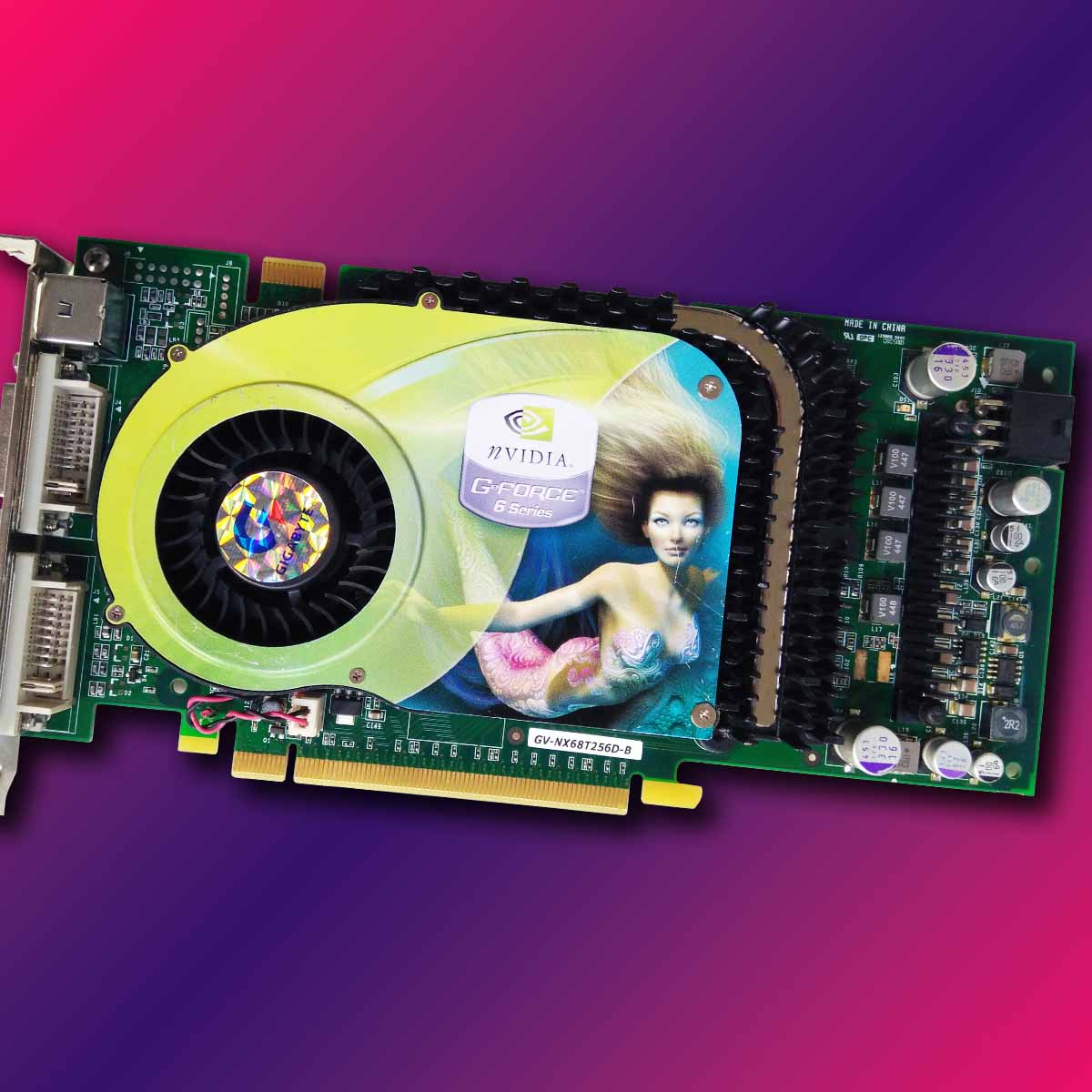
5. Nvidia GeForce 6800 GT
Nvidia needed to fight back hard after the troubled launch of its first DirectX 9 GeForce FX GPUs, and its Curie architecture absolutely delivered the goods when it launched in 2004. For a start, performance was amazing, absolutely obliterating everything that had come before it. But there were several other tools in the Curie box as well.
One of them was full support for DirectX 9C, which brought HDR rendering to the table. A patch soon appeared to enable it in Far Cry, transforming the game with bright lights and proper depth to colours, even on a bog-standard monitor. There was another cool feature on the top of the PCB as well – a connector that enabled you to pair up two cards together.
Let’s face it, having two GPUs in your PC is just really cool, isn’t it?
By this time, Nvidia had pummelled 3dfx into submission and bought up its assets, meaning it could now use the term “SLI” when chaining up several graphics chips in tandem. Nvidia’s stood for “scalable link interface”, rather than “scan line interleave” and it meant you could add even more graphics power to your rig, as well as having the option to upgrade without chucking your old card.
Curie’s top chips in the lineup were the GeForce 6800 GT and Ultra, and both of them had the same core specs, with 16 pixel shaders, six vertex shaders, and 256MB of GDDR3 memory. The Ultra was clocked higher and more expensive, but it was the GT that captured the flag, with very similar performance, a cheaper price, and a smaller cooler.
We’re glad to have seen the back of SLI now, given all the compatibility problems it regularly introduced, but we loved it at the time, despite its faults. It was rarely twice as fast, but it usually gave your frame rates a good leg up. Plus, let’s face it, having two GPUs in your PC is just really cool, isn’t it?
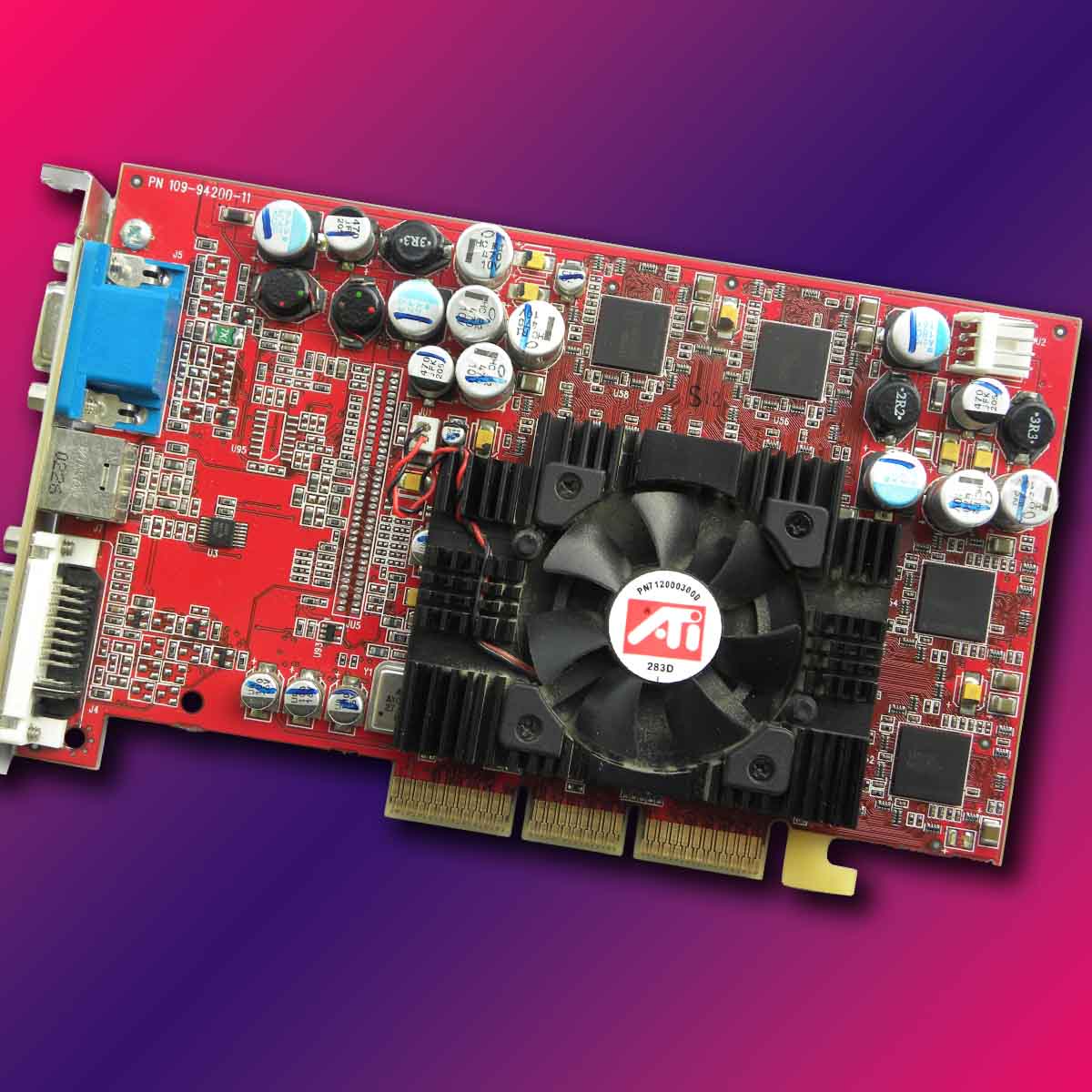
4. ATi Radeon 9700 Pro
AMD might have been playing a long game of catch-up with Nvidia over the last few years, but there was a time when ATi (the graphics firm that was eventually bought by AMD) regularly snuck in front of Nvidia and beat it at its own game. The biggest example that stands out is the mighty Radeon 9700 Pro, which introduced us to DirectX 9 shaders for the first time.
While GeForce 3 had already kicked off the shader revolution in the DirectX 8 era, its shaders had to be written in assembly, and were generally a faff for game developers to implement. DirectX 9 brought in the much friendlier (by comparison, anyway) C-style high-level shader language (HLSL). This change not only made it easier to write shaders, but it also enabled you to make them more complex. DirectX 9 underpinned the graphics tech in several big games, including Doom 3 and Half-Life 2, and it was the ATi Radeon 9700 Pro that brought us the first compatible hardware.
The widely-lampooned “dust buster” GeForce FX 5800 Ultra couldn’t compete
When it launched in 2002, Nvidia only had DirectX 8 hardware. Then, when it did eventually launch its first DirectX 9 GPU, the widely-lampooned “dust buster” GeForce FX 5800 Ultra, it couldn’t compete with the 9700 Pro, with inferior specs and a bizarrely noisy cooler.
ATi got it bang on with this card, which gave you eight pixel shaders and four vertex shaders (compared to just four and one respectively on GeForce 3), mounted on a neat little red PCB with a dinky cooler. Meanwhile, its 128MB of DDR memory was attached to a 256-bit interface, and it all fitted into a single expansion slot. You just need to hook up a floppy power connector to give it enough juice, and you were away.
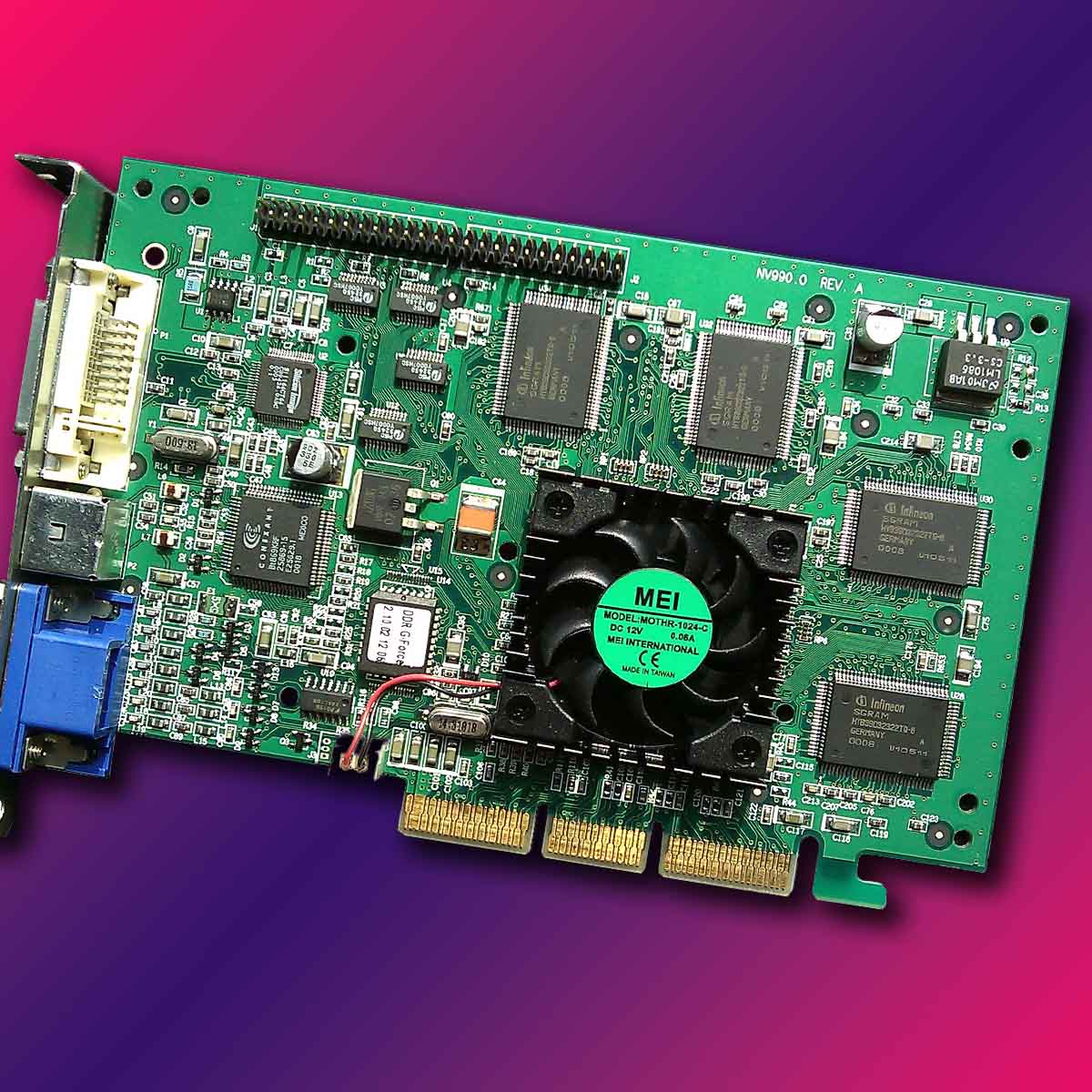
3. Nvidia GeForce 256
Nvidia completely redrew the boundaries when it unleashed the OG GeForce, with which it introduced us to the term “GPU” for PC gaming graphics in its marketing, and consigned its old Riva TNT brand to the great silicon bin of history. Using GPU as a tech term was a masterstroke that’s stood the test of time – a quarter of a century later, GPUs are regularly discussed in mainstream news, and the term is widely used as a synonym for graphics card.
Nvidia’s reasoning for the new term was that GeForce 256 could now process the entire 3D graphics pipeline, as it could now also run transform and lighting calculations in hardware. These were previously in your CPU’s domain, meaning the speed of your processor still had a substantial impact on frame rates – much more so than today. But GeForce 256 could indeed now do the whole lot, freeing up your CPU to concentrate on other jobs.
Using GPU as a tech term was a masterstroke that’s stood the test of time
As with GeForce 3 and the first shaders, this wasn’t an essential at the time. In fact, there wasn’t much you could run on a GeForce 256 that you couldn’t run on competing graphics cards, as you could still process T&L in software anyway. I remember it was a tough one to benchmark at the time as well, as it was hard to point to definite benefits of the tech – the helicopter test in 3DMark2000 came in very handy here.
Importantly, though, GeForce didn’t just give you hardware T&L, but it was also massively more powerful than anything else on the market. It made a mockery of Voodoo3’s performance, as well as its lack of 32-bit colour rendering, and it trounced ATi’s Rage chips. The latter could only compete by pairing up two Rage chips on a single card, and even then, you still didn’t get hardware T&L. Nvidia hasn’t looked back since.

2. Nvidia GeForce GTX 1080 Ti
Widely regarded as the GOAT among many PC gamers, the GTX 1080 Ti represents the peak of pure raster cards. It was an absolute speed demon for 3D rendering, and it didn’t demand the huge price of a Titan card either. Nvidia’s Pascal architecture absolutely nailed the rasterisation formula when it launched in 2016, offering a huge amount of processing clout, while substantially reducing power draw compared to Nvidia’s previous Maxwell GPUs.
The GTX 1080 Ti wasn’t the most powerful desktop Pascal GPU – that title belongs to the Titan XP – but its $699 price nearly halved the $1,199 you needed to raise for the top card. With 3,854 CUDA cores, a wide 352-bit memory interface, and an 11GB frame buffer that even now puts some of the latest Nvidia GPUs to shame, the 1080 Ti was an absolutely killer GPU. You could play games at 4K then, and even now you can still play lots of the latest titles at 1080p with decent settings, just not with hardware-based ray tracing.
Despite having this huge processing might on tap, the GTX 1080 Ti only needed two power connectors (one 8-pin and one 6-pin), and had a TDP of just 250W. It represents a moment in time when everything met up, with amazing performance, low power draw, and a surprisingly reasonable price. We’d love to see Nvidia do this again.

1. 3dfx Voodoo
It might not be the PC’s first, or even the second, 3D accelerator, but it was the 3dfx Voodoo that really captured the imagination of PC gamers when it launched in the 1990s. Until this point, it was generally accepted that your CPU would handle the 3D graphics pipeline in games, and we were happy until we saw the difference when you plugged a Voodoo card into your PC. Heck, even the name was as cool as ice.
Even to this day, I don’t remember seeing such a substantial leap in graphics quality from a single component upgrade. The jump to shaders and RTX was definitely big, but it simply can’t beat the huge difference between software and hardware rendering.
We’re not just talking about an increase in frame rates, but an earth-shattering effect on visual fidelity. Yes, the resolution went up from 320×240 to 640×480, but more importantly, the graphics at that resolution looked smooth, and didn’t assault your face with a mess of chunky pixels. At least, not compared to rendering on just the CPU. There were really cool effects we’d never seen before as well – the reflective surfaces in Unreal and the bundled Valley of Ra demo were gobsmacking at the time.
The reflective surfaces in Unreal and the bundled Valley of Ra demo were gobsmacking
Unlike today’s GPUs, the first Voodoo cards were 3D-only, meaning you needed a 2D card as well. I had a Cirrus Logic 5446, which I hooked up to my Maxi Gamer 3D Voodoo card with a loop-back cable, for example. A standard Voodoo card gave you 4MB of RAM, plus two chips – a texture mapper (wonderfully called T-Rex) and a frame buffer interface.
Importantly, the Voodoo worked in a lot of games, largely thanks to 3dfx’s proprietary GLide API, with patches to run big titles like Tomb Raider and Quake in full Voodoo glory. It wasn’t long before new games, such as Jedi Knight 2 and Quake 2, started supporting it as standard. Unlike competing PowerVR cards, you could also get going with a Pentium 90 (I even had one in my Pentium 75 machine and it worked fine), rather than requiring a newer and more expensive MMX CPU.
3dfx proved that PC gamers had an appetite for hardware-accelerated 3D graphics, and played the biggest role in setting the GPU rollercoaster in motion. It’s still the upgrade I remember most fondly throughout my many decades as a PC gamer.
Honourable mentions
We decided to stick to just 10 GPUs for this feature, but there were many others under consideration that nearly made the cut. Sometimes these were great GPUs that ended up suffering from poor availability, pushing up prices. Sometimes they were great, but not quite as great as one that made the list. Some of them would definitely make it to a top 15. Anyway, here are the GPUs that were close but no cigar.
- Nvidia GeForce RTX 4090
- AMD Radeon RX 9070 XT
- 3dfx Voodoo 3 3000
- Nvidia GeForce GTX 1060 6GB
- AMD Radeon HD 7970
- Nvidia GeForce RTX 3080
- ATi Radeon X1800 XT
- Matrox Millennium G400
- Nvidia GeForce 4 Ti 4200
- Nvidia GeForce 8800 GT
There have been plenty of other contenders along the way as well. We haven’t even mentioned the likes of PowerVR or S3, who also played their part in the PC’s 3D gaming graphics journey, even if their products didn’t make the cut.
If you’re looking to buy yourself a new GPU now, then make sure you check out our guide to buying the best graphics card for your needs, as well as our latest reviews. You can also follow Club386 on Google News to make sure you stay in the loop with all the latest GPU tech.

